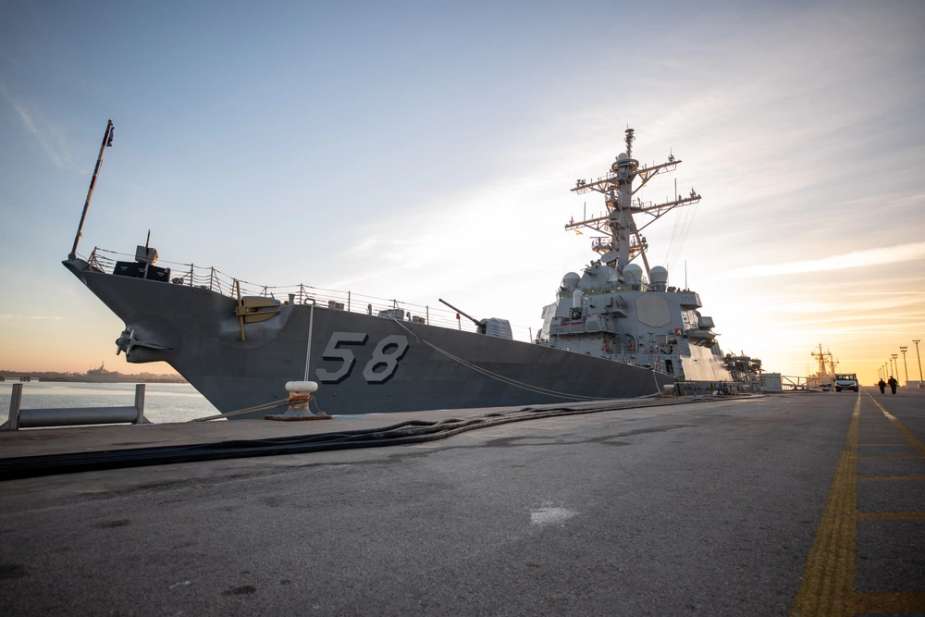Breaking news
US Navy destroyer USS Laboon intercepts Houthi suicide drone Southern Red Sea.
On January 6, 2023, the US Central Command (CENTCOM) reported that an unmanned aerial vehicle launched from Houthi-controlled areas in Yemen with reported Iranian backing was intercepted and destroyed by the USS Laboon (DDG 59) in international waters of the Southern Red Sea, near multiple commercial vessels. There were no casualties or damage reported.
Follow Navy Recognition on Google News at this link
 The Arleigh Burke-class guided-missile destroyer USS Laboon (DDG 58) in the port of Rota, Spain, on 11 December 2023. (Picture source: US DoD)
The Arleigh Burke-class guided-missile destroyer USS Laboon (DDG 58) in the port of Rota, Spain, on 11 December 2023. (Picture source: US DoD)
The USS Laboon (DDG-58) is an Arleigh Burke-class destroyer commissioned in 1995. In 1996, it became the first Arleigh Burke-class destroyer to participate in combat by launching Tomahawk missiles at targets in Iraq.
With a fully loaded displacement of approximately 8,900 long tons, the USS Laboon measures 505 feet (154 meters) in length, with a beam of 59 feet (18 meters) and a draft of 31 feet (9.4 meters). It is powered by two shafts, enabling it to reach speeds exceeding 30 knots (56 km/h; 35 mph) and maintain a range of 4,400 nautical miles at 20 knots.
In terms of armament, the USS Laboon is armed with a wide array of weaponry, including a 5-inch (127 mm) lightweight gun, a 20 mm Phalanx Close-In Weapon System (CIWS), a 25 mm Mk 38 machine gun system, missile launchers for Harpoon anti-ship missiles, a vertical launching system (VLS) for surface-to-air missiles, Tomahawk cruise missiles, and ASROC anti-submarine rockets. Additionally, the vessel can operate one Sikorsky MH-60R helicopter.
The USS Laboon is part of Carrier Strike Group 2 (CSG-2), which includes the Nimitz-class aircraft carrier USS Dwight D. Eisenhower (CVN 69), along with various squadrons from Carrier Air Wing (CVW) 3. The group also comprises Ticonderoga-class guided-missile cruisers USS Philippine Sea (CG 58), USS Monterey (CG 61), and USS Vella Gulf (CG 72), as well as Arleigh Burke-class guided-missile destroyers, including USS Mitscher (DDG 57), USS Laboon (DDG 58), USS Mahan (DDG 72), and USS Thomas Hudner (DDG 116), all under the banner of Destroyer Squadron (DESRON) 22.
It's worth noting that the deployment of this strike group in the region was preplanned and not a direct response to the ongoing Middle East conflict. Rear Admiral Marc Miguez, the commander of the strike group, has acknowledged that its presence may have implications for relationships with allies and partners. Meanwhile, US Defense Secretary Lloyd Austin has recently directed the USS Gerald R. Ford to prepare to assist Israel, underscoring the strategic significance of having two carrier strike groups in the region.
Several other Arleigh Burke-class guided-missile destroyers, including the USS Carney, USS Gravely, USS Mason, and USS Thomas Hudner, have recently been involved in intercepting Houthi missiles.
These interceptions are part of the ongoing tensions involving Houthi rebels in Yemen, who receive support from Iran. The region's complexity has been further compounded by the US involvement in the Israel-Hamas conflict in the Gaza Strip. Various groups in the Middle East, such as Hezbollah and the Houthis, have issued threats against Israel and the United States, aligning themselves with the Palestinian cause.
The successful defense operation conducted by these Arleigh Burke-class guided-missile destroyers forms a part of a broader naval initiative named Operation Prosperity Guardian, initiated by the Pentagon in December 2023 to counter Houthi-led attacks on Red Sea shipping. The operation's primary objective is to secure Red Sea shipping lanes against Houthi threats, given the numerous attacks on commercial vessels.
Despite the Houthis' declaration to block Israeli vessels from transiting the Red Sea in response to Israel's actions in Gaza, their attacks have extended beyond Israeli ships. This has prompted various shipping companies to reroute their vessels, highlighting the wider implications of these hostilities on global trade. Notably, the Red Sea and the Gulf of Aden are critical conduits for global commerce, with approximately 10% of worldwide trade passing through this vital area.






















